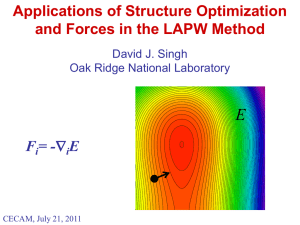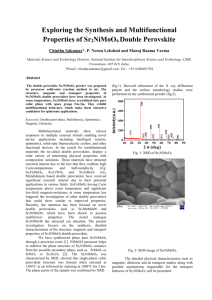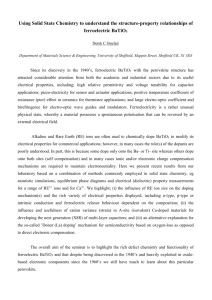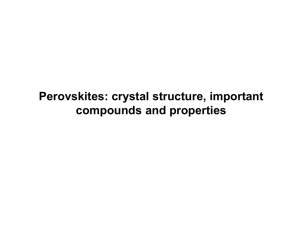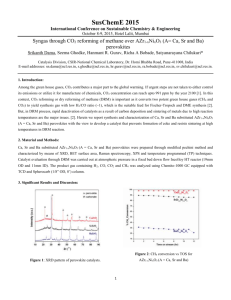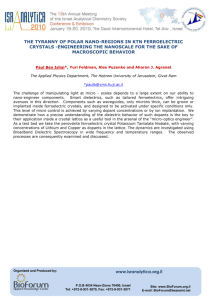Lecture 2
advertisement
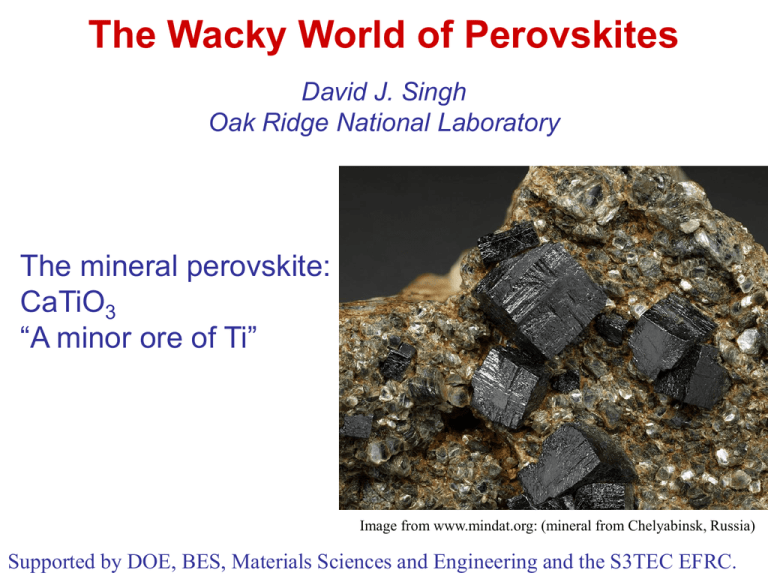
The Wacky World of Perovskites David J. Singh Oak Ridge National Laboratory The mineral perovskite: CaTiO3 “A minor ore of Ti” Image from www.mindat.org: (mineral from Chelyabinsk, Russia) Supported by DOE, BES, Materials Sciences and Engineering and the S3TEC EFRC. WARNING If you do not ask questions, I will. (corollary) If you do not contradict me, I will. Structure of CaTiO3 Ti O Ca Key structural feature is corner sharing TiO6 octahedra. CaTiO3 is pseudocubic (orthorhombic, a distortion of a cubic structure). Perovskite Variants Cubic Perovskite 6 Layered Perovskites Double Perovskite, e.g. Sr2YRuO6 What’s Interesting • Tendency towards sometimes complex structure distortions (as in e.g. CaTiO3. • Many perovskites are metallic and many are not. Sometimes one can tune between metallic and insulating states by “small” perturbations. • Many perovskites exist with magnetic ions both on the Ca site, such as various rare earth’s and the B-site, such as various 3d transition elements e.g. GdFeO3. • There is often strong coupling between degrees of freedom in perovskites – structure – magnetism – electronic properties. • The perovskite family allows wide chemical flexibility – many compounds can be formed. Example: CMR Manganites Schiffer et al. (1995) Ramirez et al. (1996) La1-xCaxMnO3 Phase Diagram All phases show local moment magnetism as expected for 3d high spin ion due to Hund’s coupling. Wide variety of magnetic phases: coupled metal insulator transitions, orbital orderings, spin orderings. Properties • Main families of ferroelectrics used in applications – Pb(Zr,Ti)O3, BaTiO3, (K,Na)NbO3, (Ba,Sr)TiO3 etc. • Electronics, medical ultrasound, actuators, sonars, microwave devices, motion detectors … • Colossal magnetoresistance (manganites). • High TC half-metal ferromagnets: Sr2MoFeO6 … • High-Tc superconductors: Cuprates, (Ba,K)BiO3. • …. STRUCTURE AND IONIC SIZE (Ferroelectrics) SSN21 Seawolf What are Ferroelectrics? +Vf Q 0 Note analogy with Ferromagnets Producing a Ferroelectric Linear chain of charged atoms (e.g. H and F) - + - + - + - + - + - + - + or - + - + - + Tensile strain Symmetry breaking - + + - Coulomb interactions and covalent bonds favor ferroelectric Closed shell repulsion oppose ferroelectric Medical Imaging Materials discovery to commercial products in less than seven years PZT 2000 Piezocrystal: 2004 Electronics and Others Ferroelectric memories: Ramtron Fujitsu Samsung Passive components: EPCOS and many others Actuators: Microwave/Radar: Phased array radar lens J.B.L. Rao et al. Piezoelectric fuel injector (Bosch) Pyroelectric Effect Motion detectors, X-ray generators Neutron generators How Does PZT Work? Cubic Perovskite Structure Tetragonal FE TO() unstable phonon (Ferroelectric) Ground state can be tetragonal, orthorhombic, rhombohedral or monoclinic. Jaffe, Cook, and Jaffe, (1971). Piezoelectric Ceramics PZT near the morphotropic phase boundary is the basis of current devices What is the Size of an Atom? The Size of an Atom • Goldschmidt; Pauling; Shannon and Prewitt Inter-atomic distance, d = rA + rB Crystallographic data “defines” the “sizes” of atoms. d INSTABILITIES OF PEROVSKITES Chemical Understanding: • Main interactions are (1) Coulomb (ionic) and (2) Closed shell repulsions. Competition of bond lengths drives most perovskite instabilities. Tolerance Factor: t = (rA+rO)/2(rB+rO) (a) t>1 (B ion [Ti] is too small) B site off-centering and ferroelectricity (BaTiO3, KNbO3) PbTiO3 (b) t<1 (A ion [Pb] is too small) Rotation of octahedra, e.g. CaTiO3, GdFeO3, LaMnO3… (the great majority of perovskites). Role of Pb on the Perovskite A-Site • Pb allows t<1 perovskites to be ferroelectric instead of Pnma or similar. Electronic Structure: Pb O R.E. Cohen, 1992 Zr/Ti Cross-gap hybridization: 6p 3d/4d • Increases Z* • Softens interactions EF • Increases polarizability • Favors Ferroelectricity 2p 6s What’s going on here? unoccupied H EF E occupied Occupied states decrease in energy a chemical bond n.b. mixing of occupied states is not a bond! Are there Pb-free materials that are as good as or even better than the Pbbased materials, e.g. PZT? BiFeO3: • A very high polarization material based on structure (Tomashpol’skii, 1967), but not usable due to conductivity. Answer was long thought to be no… … but results in the last decade for materials such as BiFeO3 suggest a closer look. Lebeugle et al., APL 2007, room temp. How Much of a Good Thing is Enough? The Perovskite Structure Pauling Rules - JACS 51, 1010 (1929). 1. “the cation-anion distance being determined by the radius sum and the coordination number of the cation by the radius ratio” 2. “charge of each anion tends to compensate the strength of the electrostatic valence bonds reaching it” 3. “shared edges and particularly shared faces … decreases stability; this effect is large for cations with large valence …” Problem: from www.crystalmaker.co.uk • Bi3+ vs. Pb2+ implies lower average B-site charge. • Bi3+ has c.r.~1.3 Å << Pb2+ (1.63 Å). Bi perovskites are often difficult to make. INSTABILITIES OF PEROVSKITES Single sub-lattice off-centering (LDA): Expt. Volume: 6% Expansion: INSTABILITIES OF PEROVSKITES Classification: 1. UA : Unstable against A-site off-centering (PZ). • t<1 • also unstable against rotation. 2. UB: Unstable against B-site off-centering (BT). • t>1 3. UAB: Unstable against both A- and B-site off-centering (PT). • t~1 • Instability not driven by tolerance factor. 4. S: Stable against sub-lattice off-centering (BZ), t~1, or ferroelectrics like KTN. PZT is an alloy between UA and UAB end-points. Not understood by tolerance factor alone. INSTABILITIES OF PEROVSKITES LDA calculations constrained to rhombohedral ferroelectric Displacements in Bohr along x direction (0.529 3 Ang. disp.) Ghita, Fornari, Singh, Halilov (‘05) Cooperative A-site and B-site displacements characterize good perovskite ferroelectrics Phonons In Ferroelectric Perovskites First Principles Calculations of Ghosez et al. (1999): • note R point instabilities in PZ and PT but not BT. • Note different coherence lengths for zone center and zone boundary instabilities. ROTATIONAL (TILT) MODES • Distortion around A (A-O bond lengths) • Bends B-O-B bonds but only bond lengths in second order. (n.b. breathing mode is usually stiff). • Driven by pressure and/or tolerance factor if octahedra are stiff. • Alternate is A-site off-centering (Pb). Volume Dependence of Modes (50-50 PZT) •Fornari and Singh, 2000. Ferroelectric Mode () Rotational Mode (R) • Volume dependence of FE and Rotational Instabilities is large and opposite. • Implies co-existence in disordered alloys due to local stress fields. •Confirmed, Ranjan et al, PRB 2002 (neutron scattering). What If … … we could eliminate the tilt instability from arbitrary t<1 perovskites? First principles get ferroelectricity Strain Coupling Allowing only ferroelectric states & at the LDA lattice parameter: t ~ 0.9 Why are these so different • Note rhombohedral ferroelectric phase is very much more stable than tetragonal. • Note large ferroelectric energy. • Also note the large c/a of the tetragonal. R-FE vs. T-FE LDA ENERGETICS •A site ion is 12-fold coordinated (very isotropic). •B site ion is 6-fold (octahedral). Expectation: Without strain A-site driven materials (t<1) should be isotropic. With strain they should all be tetragonal. B-site driven materials (t>1) should be rhombohedral unless strain is very important. Not true: Reason is cooperativity involving Bsite. Concept of Bond Valence • I.D. Brown based on crystallography (c.f. ionic radius). • For a given valence a sum involving bond lengths is nearly constant A sum involving bond lengths yields valence. Tables of R0 and b are in various sources: Brown, I. D.; The Chemical Bond in Inorganic Chemistry - The Bond Valence Model. IUCr monographs on Crystallography 12, Oxford University Press, (2002). Brown, I. D.; in Structure and Bonding in Crystals, edited by M. O'Keeffe & A. Navrotsky, Vol. II, pp. 1-30. New York; Academic Press (1981). Some Consequences of Bond Valence Focusing on metal site: Push an O in and the others go out. Focusing on O sites: Mechanism for interplay of A and B site displacements and local correlations of cation displacements. Application to Ferroelectrics •Grinberg, Cooper, Rappe, Nature (2002). •Structure relaxation of large supercells of PZT. Pb displacements avoid Zr rich directions. Complex structures with non-collinear cation displacements could be understood in terms of bond valence. Potential model based on this was made and used to study very large cells – PDF’s agree with experiment. CRYSTAL FIELD AND JAHN-TELLER DISTORTIONS The d Orbitals eg orbitals point at the corners of the octahedron t2g orbitals do not. From Vinobalan Durairaj web site The O p Orbitals From wikipedia • One of these (p) points at the center of the octahedron. • The other two (p) are perpendicular. The Octahedral Crystal Field H E M e2g anti-bonding Md M t2g anti-bonding Op O p bonding O p bonding In transition metal oxides crystal field is due (mostly) to hybridization An Example: PbZrO3 (cubic) Note Zr d contribution at bottom of O bands Jahn-Teller Effect E H eg* M eg E EF eg For a sufficiently narrow level with partial occupation, we expect a splitting to lower the energy. How does this happen (i.e. what is H)? Large band-width works against this. Jahn-Teller Effect z d x2-y2 d z2 A kind of orbital ordering. The same thing works for t2g orbitals but the effect is (much) smaller because these are involved in weak bonds instead of strong bonds Cooperativity Jahn-Teller is long range – corresponding zone boundary modes have long coherence length (zone center also possible – ferroelastic) BAND FORMATION (eg and t2g) Geometric Considerations (O and B-site) Cubic structure: • O – O distance is a/2 (can have direct hopping) • B – B distance is a (too far for much direct hopping). Metal bands are formed via hopping through O. 1D linear chains along Cartesian directions 1D and 2D bands. Geometric Considerations (O and B-site) Flat bands Planar Fermi surfaces (e.g. cubes rather than spheres). Cubic SrRuO3 High-Tc Electronic Structures are 2D Pickett, Cohen, Krakauer, Singh M. Opel Hopping Through O O px,py,pz point along Cartesian directions (90 degrees apart): Cubic: Tilted: • Reduced pd hopping. • Maximum pd hopping. • Narrower eg bands. • Wide eg bands. • Additional splittings due to symmetry lowering. Tilts reduce band width but do not reduce hybridization (i.e. crystal field). • Can broaden t2g bands depending on details. • Direct m-m hopping. Tilts and Hopping Through O (Sr,Ca)2RuO4 (Nakatsuji) (Friedt et al., 2000) MAGNETISM: Moment Formation Local Atomic Moments (Hund’s Rules) 1. For a given electron configuration, the term with maximum multiplicity (maximum S) has the lowest energy (exchange / Coulomb correlation). 2. For a given multiplicity, the term with the largest value of L has the lowest energy (Coulomb correlation). 3. For a given term, in an atom with outermost sub-shell half-filled or less, the level with the lowest value of J lies lowest in energy. If the outermost shell is more than half-filled, the level with highest value of J is lowest in energy (spin-orbit). 1st Rule: In solids levels broaden into bands. If band width, W > this may not work ( low spin). Stoner Model (Itinerant Magnets) Band structure effects can lead to high degeneracy near EF magnetic instability and energy lowering. Stoner Criterion: N(EF)I > 1 I ~ 0.7 – 0.9 eV for d elements. mSCF = 1.2 B Interaction Between Moments (Exchange) • Moment formation by itself is not magnetism. Ordering is required, and therefore interactions between moments on different sites are what underlie magnetism. • Some Mechanisms: • Direct exchange – two atoms are touching (or very close) so that their wavefunctions overlap. The interaction is like that which gives rise to Hund’s first rule. It can be positive or negative depending on the separation of the atoms, but it falls off very strongly with distance. • Super Exchange – coupling of spins through spin dependent overlap typically involving other atoms. • Conduction electron mediated exchange: e.g. RKKY, magnetic semiconductors … Moments interact with conduction electrons which mediate the coupling. Conduction Electron Mediated Exchange In weak interacting limit medium has some response, (q), which defines the interaction through (ri-rj). More generally the response may differ for strong interactions at short range but at long distance would still take RKKY type form in a metal. Super Exchange and Related Consider two magnetic ions which interact via O and consider parallel and anti-parallel alignments of the moments: Parallel A Maj. Anti-parallel B Min. Maj. A Min. Maj. B Min. Global Spin Direction Min. Maj. Band Formation In the absence of spin orbit and non-collinear structures hopping is separate for spin up and spin down. Parallel Case with hopping: Parallel Case: A Maj. B Min. Maj. A Min. Maj. B Min. Global Spin Direction Maj. Min. Band Formation In the absence of spin orbit and non-collinear structures hopping is separate for spin up and spin down. Anti-parallel Case: A Maj. Anti-parallel with hopping: B Min. Min. A Maj. Maj. B Min. Global Spin Direction Min. Maj. Antiferromagnetic Super Exchange Anti-parallel with hopping: A Maj. B Min. Min. Maj. EF Global Spin Direction Average energy of occupied states is lowered. Favors antiferromagnetic alignment (super exchange) Ferromagnetic Exchange A Maj. B Min. Maj. Global Spin Direction Min. Average energy of occupied states is lowered. Favors ferromagnetic alignment (super exchange). EF This is the nature of the double exchange in manganites: It competes with JahnTeller, which would split the eg level. What Favors Strong Super Exchange? 1.High spin state. 2.Bond angles that favor M – O – M hopping (i.e. 180o for eg). 3.Strong hybridization with O. • Large orbitals that overlap strongly with O (eg much better than t2g). • Short M-O neighbor distances. • d-states that are close in energy to the O p states (e.g. high metal valence states like Cu2+). • In perovskites the interaction proceeds through O. Example: Cuprate Superconductors (Spin ½) Tl2Ba2CuO6 Note hybridization of Cu and in-plane O(1) Highest Tc cuprates have long apical O bond (and short in plane bonds), are hole doped and have flat CuO2 planes (straight bonds). An Example (R2NiMnO6) Double Perovskite Azuma et al., Oratani et al., Mater et al., DJS et al. A ferromagnet via standard Anderson super exchange. Another Example PbVO3 Perovskite, polar tetragonal structure P4mm; extreme c/a ~ 1.23. Shpanchenko (2004), Belik (2005), Uratani (2005), DJS (2006). Ionic model: Pb2+V4+(O2-)3 • Two stereochemically active ions: Pb • Pb2+ on A-site O • V4+ on B-site (also magnetic) V • No transition with T up to 570K • Tetragonal to Cubic transition at P~2 GPa. Perovskite Instabilities • B-site driven: • Classic ferroelectrics (e.g. BaTiO3) • B-site – O hybridization is important. • A-site driven: • Tilted structures (e.g. CaTiO3) • A-site stereochemical activity (Pb – O hybridization) can give strong ferroelectricity (e.g. PZT). • Morphotropic phase boundaries (piezoelectrics). • Short FE coherence length interesting nanostructures and high temperature relaxors. • PbVO3 has strong stereochemical activity on both Aand B-site positions. Super properties? Hybridization Schemes PZT PbVO3 c/a ~ 1.015 – 1.06, TC ~ 250 – 450 °C Pb O Zr/Ti c/a ~ 1.23, TC unknown Pb O V 6p 6p 3d/4d 3d EF ? 2p 2p 6s 6s See Cohen (1992). V4+ in Oxides Two normal configurations: CaVO3, SrVO3 K2V3O8 …. Sr2VO4 …. PbVO3 Metal or Mott Insulator. Magnetic insulator. Short bond (1.55 – 1.60 Å) Moment Formation in PbVO3 •LDA Calculations with LAPW method, c.f. Shpanchenko, Uratani. •Stable local moments on V (ms=1B). •Ground state is AF C-type. Conf. E(meV) NSP 0 F -111.2 G -127.3 A -91.8 C -127.8 The Vanadyl Bond z2 eg x2-y2 xz,yz t2g xy Op Op Op Op Isotropic Octahedral Vanadyl Hund’s Vd SrVO3, CaVO3 EF PbVO3 Structure of PbVO3 Why does PbVO3 form a highly tetragonal structure with short V-O bond, while SrVO3 and CaVO3 do not? Not ion size (c.f. Sr, Ca). Metastable structure that could be made with e.g. CaVO3? •LDA Structure Relaxation (FM PbVO3): LDA Expt. zV 0.5689 0.5668 zO1 0.2158 0.2102 zO2 0.6872 0.6889 (ag)=190, 408, 838 cm-1 V-O bond length = 1.67Å. Structure of PbVO3 Does the V-O vanadyl bond form because of ionic forces? LDA calculations for hypothetical CaVO3 in the PbVO3 structure. PbVO3(FM) M(B) FV(mRy/a0) CaVO3(FM) 1.0 0.88 0* 80 Vanadyl destabilized. t2g bands broadened. V moment is reduced. Reason is competition of V-O and Pb-O hybridization in PbVO3. Large force pushing vanadyl bond apart V moment is reduced CaVO3 (FM) PbVO3 structure MAGNETOELASTIC COUPLINGS Why is Magnetism Coupled to the Lattice? 1. Moment formation affects bonding. • Difference in size of high spin and low spin ions (Shannon). • Moment formation competes with bonding (bonds have paired electrons in normal cases) -- Invar 2. Exchange interactions depend on structure through hopping integrals and on-site terms (relative shifts in levels). 3. Relativistic effects (spin orbit and Dzyaloshinsky-Moria) couple spin directions to the lattice – magnetostriction, moment canting. How Does It Work? Heisenberg Model J ~ t2/E But both E and t depend on position – The hopping t is from wave function overlap, which is very strongly dependent on distance (exponential) and bond angles. J J(ri-rj,) J J J J “Spin-Dimer” A kind of bonding Can accomplish the same thing with M – O – M bond angles in perovskites or by lattice strain (e.g. MnO). Big Effects Ibarra et al.,PRL (1995). Large lattice signatures of changes in magnetic order with eg electrons. SOMETHING NEW: A-Site Disorder ROTATIONAL MODE • Distortion around A (A-O bond lengths) • Bends B-O-B bonds but only bond lengths in second order. (n.b. breathing mode is usually stiff). • Driven by pressure and/or tolerance factor if octahedra are stiff. • Alternate is A-site off-centering (Pb). What If … … we could eliminate the tilt instability from arbitrary t<1 perovskites? CdTiO3 and Alloys with PbTiO3 Density functional calculations for CdTiO3 (small tolerance factor, possibly interesting chemistry) • CdTiO3 has antiferroelectric ground state. • If forced ferroelectric it has a large tetragonal strain in the tetragonal FE state, and high energy scale. “Ferroelectric CdTiO3” • Supercells for 50-50 CdTiO3PbTiO3 are borderline ferroelectric and tetragonal and have a large c/a~1.08 (higher than PbTiO3). S.V. Halilov, M. Fornari and D.J. Singh, Appl. Phys. Lett. 81, 3443 (2002). Experimental Confirmation This was the second example of an alloy with PbTiO3 that increases c/a. Phonons In Ferroelectric Perovskites First Principles Calculations of Ghosez et al. (1999): • note R point instabilities in PZ and PT but not BT. • Note different coherence lengths for zone center and zone boundary instabilities. ROTATIONAL MODE Can we use disorder to exploit the difference in coherence length between rotational and ferroelectric instabilities? Hypothetical Perovskite: K0.5Li0.5NbO3 • K and Li have very different sizes (1.8Å vs. 1.1Å). • What if we make a perovskite alloying K and Li on the A-site? • Strong off-centering of Li (A-site driven ferroelectric) – Tilt does not happen. D.I. Bilc and D.J. Singh, PRL 96, 147602 (2006). Single ion off-centering •Reason for tetragonal state is the very large displacement of Li. LATTICE INSTABILITIES IN PEROVSKITES (Design Rules) 1. Hybridization between unoccupied A-site states and O 2p states favors ferroelectricity in t<1 perovskites. 2. Alloying small A-site ions favor large tetragonality if ferroelectricity can be obtained – e.g. CdTiO3 - PT 3. In materials with stiff octahedra, frustration due to a mixture of large and small A-site ions, can stabilize ferroelectricity due to the short coherence length of the ferroelectric instability and the long rotational coherence length. 4. The balance between tetragonal and rhombohedral ground states (i.e. the MPB) can be controlled via the BO6 polarizability – e.g. NbO6 vs. TaO6 1) Tc is maintained high under Ca alloying even though the average tolerance factor is strongly decreasing. 2) The system becomes much more tetragonal as Ca is added. Ba1-xCaxTiO3 A-Site Alloys with Bi • Bi0.5Sr0.5Zn0.5Nb0.5O3 was reported in perovskite structure by Kosyachenko et al. [Neorg. Mater. 18, 1352 (1982)] and evidence pointing towards ferroelectricity was found. • Bi0.5Pb0.5Zn0.5Nb0.5O3 would be the 50-50 solid solution of PZN with hypothetical BiZn2/3Nb1/3O3. • (Na,Bi)TiO3 is a known material that has been investigated alone and in alloys with PbTiO3 and KNbO3. • Bi(Zn0.5Ti0.5)O3 was shown to be a super tetragonal ferroelectric with very high polarization by Suchomel and Davies [APL 86, 262905 (2005)]. (Bi,Pb)2ZnNbO6 Supercells NaCl (111) layers 5+ A-type (100) layers • Charge difference of Nb and Zn2+ is 3 favors chemical ordering. • PbZn1/3Nb2/3O3 (PMN) has a two sub-lattice (double perovskite based) structure should be stronger for Zn:Nb ratio at 1:1. Pb Bi C-type [001] chains Clusters • Done at LDA lattice parameter somewhat compressed [3.99 Å for Pb and 3.97 Å for Sr] • LDA calculations for 40atom double perovskite supercells with various Bi/Pb orderings and rocksalt Bi/Sr ordering. BiPbZnNbO6 Relaxed G-type cell at LDA lattice parameter (3.99 Å), pseudo-cubic Cation off-centerings in O cages • Large off-centerings of Bi, but also substantial for other ions, including Nb. • Off-centering is along [111]. • Similar results for other three supercells. S. Takagi, A. Subedi, D.J. Singh and V.R. Cooper, Phys. Rev. B 81, 134106 (2010) BiPbZnNbO6 • G-type cell was relaxed as a function of tetragonal strain • Minimum energy was at a c/a ratio of ~1.015, but this appears to be due to tilts, not ferroelectricity (supercell artifact) Off-centerings for imposed c/a=1.0606 Note that offcentering does not switch to [001] even with large imposed strain. BiPbZnNbO6 G-type supercell as a function of pseudo-cubic lattice parameter: • Increasing off-centering with increasing volume, as usual (LDA may underestimate). • Substantial off-centerings of Nb. Electronic Structure Eg =2.7 eV (LDA) • Note sizable band gap even at the LDA level. Also note ions in stable valence configurations for oxides consistent with good insulating behavior. • Substantial hybridization of O 2p states with Bi p, Pb p, Nb d. Polarization: BiSrZnNbO6 and the Role of Pb BiSrZnNbO6 • Known compound that readily forms in perovskite structure. • Average A-site charge is +2.5 Av. B-site is +3.5 (better for stability of perovskite). • Polarization is comparable to pure Bi compounds even though there is only 50% Bi. • Reason is large Bi displacement & Nb off-centering. BiSrZnNbO6 – Bi2ZnTiO6 Solid Solution • Bi(Zn,Ti)O3 has a very large polarization ~150 µC/cm2 but is essentially non-switchable due to super-tetragonality, c/a ~ 1.2 (Suchomel, 2006). • Can we produce a useful MPB by alloying – key may be to alloy with a strongly R material that produces an MPB far from the BZT end so that it can be switchable. • We did supercell calculations for the pseudo-binary solid solution with BiSrZnNbO6. • We used 40 and 80 atom cells with Zn and (Ti,Nb) on separate sublattices (i.e. double perovskite). BiSrZnNbO6 – Bi2ZnTiO6 Solid Solution Average cation off-centerings in supercells: Proposed Phase Diagram Direction of P relative to 111 and 100: • We find a region with a possible MPB and high polarization, although the tetragonality on the T side is still very high. Summary The mineral perovskite: CaTiO3 “A minor ore of Ti” … pretty interesting physics though Image from www.mindat.org: (mineral from Chelyabinsk, Russia)
